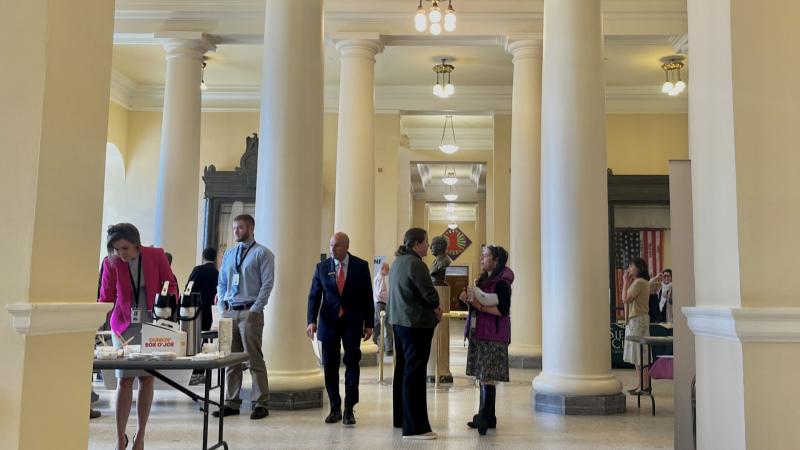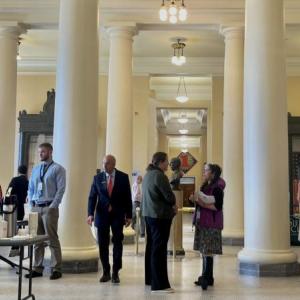Lawmakers consider bills to improve regional transportation options, increase public input
At the Penobscot Community Health Center in Bangor, Muriel Emerson spends her days working with patients as a community health assistant, sharing resources and connecting those in need with health and social services in the area.
Every day, she works with local transportation agencies to coordinate rides for her clients, who are often elderly or disabled and require accessible options — it’s a need, she said, that is growing, and one she’s familiar with herself.
Emerson lives with her father-in-law, who’s mostly blind and deaf, and her partner, who is unable to drive due to a heart condition. She uses her car to bring them to medical appointments — but recently, her car broke down, leaving her to wonder what would happen if her household lost its only vehicle.
“If anything happens to my car, I’m right back to having to walk or take the bus everywhere,” Emerson said.
Two in five Mainers lack safe, reliable and affordable transportation, according to a recent report by the Moving Maine Network, a statewide collaborative focused on reducing barriers to transportation for people who can’t drive or struggle to afford transportation. The organization refers to this as “transportation insecurity,” and found it affects the majority of Black Mainers and young adults, and more than two-thirds of blind Mainers and those with mobility disabilities.
The report states that approximately 40,000 Maine households do not have a vehicle, and a fifth of Mainers live in places where they need to travel at least 30 miles to see a doctor. Its survey found that eight percent of respondents have had to reschedule a medical appointment because of transportation issues.
Public transit options are limited throughout Maine, and currently meet only about 11 percent of the state’s total transportation needs, according to a January report from the John T. Gorman Foundation.
Maine lawmakers are considering a number of measures that aim to improve transportation in the state, including a bill that would strengthen the coordination of community transportation, with a focus on bolstering the accessibility and availability of transportation options for people who rely on others to get around.
“Transportation issues are, by and large, one of the very top issues that our clients encounter barriers with,” said Lauren Wille, the legal director of Disability Rights Maine. “When all Mainers have a difficult time getting to where they are going, the burden is higher on people with disabilities, who historically are isolated, historically don’t have full access to their communities.”
Coordinating regional transit
The community transportation bill introduced by Sen. Mike Tipping (D-Penobscot), L.D. 1451, would increase interagency coordination, create a state coordinator of mobility management and establish eight regional hubs to make better use of federal funds for public transportation, among other things.
More than 70 people submitted testimony on the bill, including the Knox and Piscataquis County sheriffs, the Maine Transit Association, community and mental health service agencies, and the American Cancer Society.
“It improves communication between state agencies and trusted local providers, without creating more bureaucracy,” wrote Rep. Abigail Griffin (R-Levant) in her testimony. “This kind of coordination means volunteers, nonprofits, and community organizations can focus on helping people instead of navigating red tape.”
“Maine currently spends over $200 million each year across multiple agencies to help people get where they need to go, yet only a fraction of that need is met,” wrote Sen. Rick Bennett (R-Oxford).
A Public Transit Advisory Council report to the legislature in February found that regional transit operators across the state are facing funding shortfalls, workforce shortages and difficulty obtaining vehicles.
The range of available options varies across the state. Aroostook Regional Transportation Systems operates across nearly 6,600 square miles, catering to people who often live far from essential services. In Cumberland County, there are a number of different providers, from the Greater Portland Metro bus system to the Regional Transportation Program, which offers rides to low-income, elderly and disabled people.
“A Mobility Manager would be able to bring all the transportation options together, discuss what needs are unmet, create solutions for those needs and act as a one stop for anyone who has transportation needs,” wrote Roberta Boczkiewicz, a resident of Castine, in her testimony supporting the bill.
Lawmakers on the transportation committee discussed the bill during a work session on May 8, and voted unanimously for it to proceed as amended.
Increasing public input
Another proposal under discussion this session would create a council to advise the Maine Department of Transportation and Maine Turnpike Authority on which projects to prioritize, in part by gathering input from municipalities, counties and planning organizations.
Rep. Adam Lee (D-Auburn) says the aim of L.D. 1756 is to provide more transparency on the selection process, and ultimately, increase public input in the decision-making process.
“It feels very much like (there’s) a bit of a black box that goes into DOT or into the Turnpike Authority, and then certain projects get funded kind of based on the work plan,” Lee said. “My intent, and part of having the local … councils involved was to maximize that public input.”
The council would publish metrics on an online dashboard. It’s modeled after Virginia’s Smart Scale, “a process that helps Virginia meet its most critical transportation needs using limited tax dollars” by evaluating “potential transportation projects based on key factors like how they improve safety, reduce congestion, increase accessibility, contribute to economic development, promote efficient land use, and affect the environment.”
A rating system would assign more points to projects that align with the transportation department’s statewide plan and projects with the best cost benefits. Lee said this would ultimately prioritize projects that connect different regions, particularly rural areas to urban centers, as those are key priorities for the state.
The measure passed unanimously in Virginia in 2014, but Lee isn’t so sure it will pass as easily in Maine.
“As with most bills like this, DOT is not crazy about being told how to do something,” Lee said.
At a hearing on the bill on Thursday, lawmakers voted the measure down unanimously without committee discussion.
Life without a car
Gianluca Yornet de Rosas first moved to Maine in 2020 to attend Bates College as an environmental studies major. He now lives in Norway, where he works as a community resilience fellow at the Center for an Ecology-Based Economy.
“I feel very happy that I get to … walk to work,” Yornet de Rosas said. “That’s not very common around here.”
He has never owned a car, but that’s because he doesn’t want one. The idea of commuting long hours to work wasn’t appealing to him, and the costs have always been too much for his budget.
Living in Maine without a car is challenging: he said he often feels disconnected and lonely, and has had trouble navigating confusing and unreliable bus routes and expensive and limited rideshare options.
“The only way that I get to go places that are not my house or my work is by bike,” Yornet de Rosas said.
At one point, he missed an important medical appointment that he had waited months to secure because he could not find a ride from friends, and had to wait months for another appointment.
He loves the scenic trails and hikes that the state offers, but that doesn’t make up for the transportation challenges, he said. He would be more interested in staying long-term if there was a clear path forward to improve public transit.
“The loneliness aspect that transportation deserts create is what keeps me from (saying), for sure, I want to be here,” he said.
This story was originally published by The Maine Monitor, a nonprofit civic news organization. To get regular coverage from The Monitor, sign up for a free Monitor newsletter here.


























